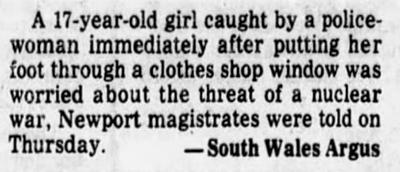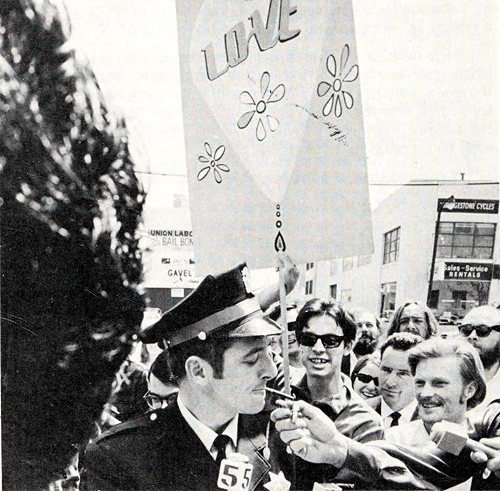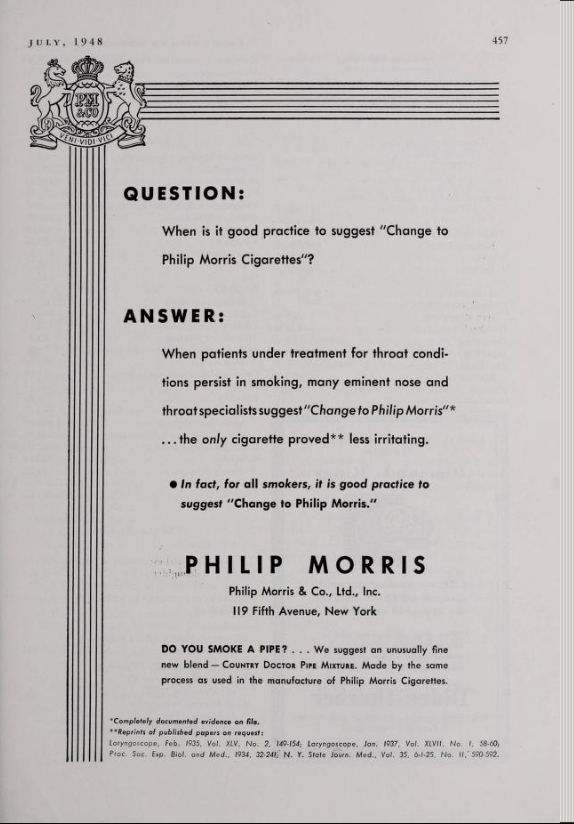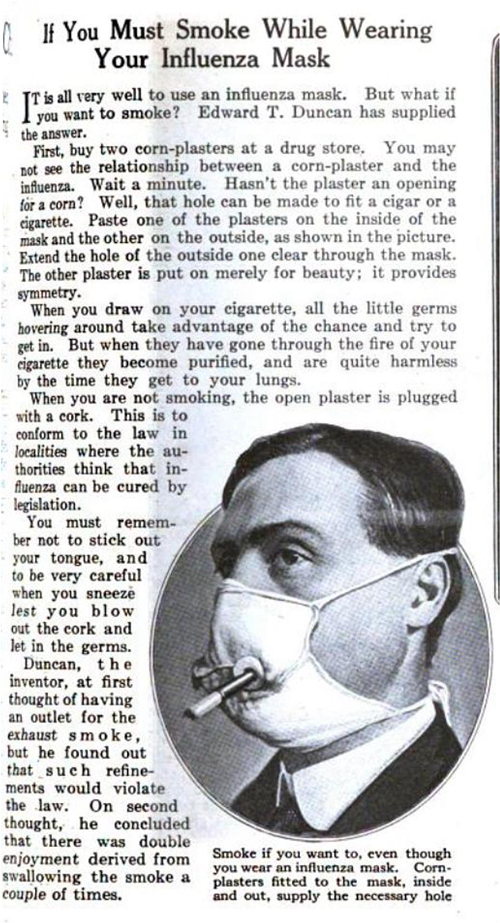Smoking and Tobacco
Hagi Pipe
From 1960. A foot-long cigarette filter that supposedly would "prevent lung cancer from smoking."
Source: Science Photo Library
Text from 1961 Congressional hearings:

Posted By: Alex - Sat Oct 15, 2022 -
Comments (2)
Category: Smoking and Tobacco, 1960s
How to smoke fewer cigarettes
This reminds me of the old joke about how to drink fewer glasses of wine a day — get a bigger glass."It's wacky, but it works!"

image source: Trinkets & Trash
contemporary source: Photoplay - Nov 1976

Posted By: Alex - Mon Sep 26, 2022 -
Comments (4)
Category: Advertising, Smoking and Tobacco, 1970s
Pyrophobia
In 1964, the pro-smoking, German scientist Helmuth Aschenbrenner argued that anti-smokers were suffering from 'pyrophobia,' or fear of fire. Specifically, they were suffering from 'fear of the 'big fire' or atom bomb."Details from Robert Proctor in The Nazi War on Cancer (1997):
On a somewhat unrelated note, here's a news item from 1981 about a young woman who was also suffering from fear of the 'big fire'.

Vancouver Sun - June 22, 1981
Posted By: Alex - Thu Jul 28, 2022 -
Comments (1)
Category: Bad Habits, Neuroses and Psychoses, Smoking and Tobacco
Sergeant Sunshine

Scott French, The Complete Guide to the Street Drug Game (1976):
He served six months in jail, and subsequently became a plumber.
Posted By: Alex - Sun May 22, 2022 -
Comments (1)
Category: Drugs, Smoking and Tobacco, Police and Other Law Enforcement, 1960s
Toothache-Killer Cigarettes

Los Angeles Times - Aug 12, 1991
A search of the patent records turned up a 1994 Chinese patent (CN1106283A) for these 'toothache-killer cigarettes':
I wonder what happens if you smoke them when you don't have a toothache. Would your mouth go numb?
Posted By: Alex - Wed Jan 26, 2022 -
Comments (3)
Category: Patents, Smoking and Tobacco, Teeth
Advice for Doctors, 1948

Posted By: Paul - Tue Sep 28, 2021 -
Comments (2)
Category: Medicine, Smoking and Tobacco, 1940s
Vanguard Tobacco-Free Cigarettes
Vanguard cigarettes, which came on the market in 1959, were advertised as containing no tobacco tars, no nicotine, and no arsenic. So what did they contain? It was a mystery substance called 'Fibrila'.The FDA examined a sample of Fibrila and determined it was a blend of "sugar cane bagasse, licorice and corn silk." But mostly corn silk.
Corn silk is that stringy stuff you have to remove before eating an ear of corn. Apparently it's long been a popular tobacco substitute among teenagers denied access to real cigarettes. And it's possible to make a tea out of it as well.

The Hackensack Record - Sep 24, 1959
Posted By: Alex - Mon Sep 27, 2021 -
Comments (5)
Category: Smoking and Tobacco
You’re never alone with a Strand
The 1959 "Lonely Man" TV ad for Strand cigarettes is rumored to be the greatest advertising flop in UK history. Because it seemed to say, "If you smoke our cigarettes, you may become a lonely sad sack wandering the streets at night."Rob Gray has some analysis of the failed commercial in his book Great Brand Blunders:
The style of the protagonist and soundtrack to the commercial appealed to the public. Once it went on air people began getting in touch to find out if the theme tune was available to buy as a record. Sensing an opportunity, Cliff Adams and His Orchestra booked some recording studio time and laid down the track, The Lonely Man Theme, for release as a single. In 1960 The Lonely Man Theme broke into the Top 40...
Undeniably, the advertising campaign earned Strand tremendous recognition. As Winston Fletcher writes in his book Powers of Persuasion: The Inside Story of British Advertising 1951-2000, 'Public awareness of the brand and its advertising rocketed to over 90% within weeks. This was unprecedented and has rarely if ever been surpasssed.' It was a brilliant achievement, but one with a fatal flaw. Despite the high awareness levels delivered by the campaign, hardly anyone was buying the product.
The reasons why revolved around how the Lonely Man was perceived. Many viewers found the focus on loneliness uncomfortable. If the man was reliant on a packet of smokes for company, did this mean he was a bit of an oddball unable to sustain friendships? Was he an addictive personality, craving nicotine above human company? Could he be on his own because of a failed relationship or even due to bereavement? Might he be depressed?...
trying to position a new tobacco brand around loneliness — rather than something much more positive and aspirational, such as individuality — was doomed to failure. With sales failing to take off despite the high level of standout the advertising achieved, Strand was soon withdrawn from the market.
Posted By: Alex - Tue Sep 21, 2021 -
Comments (2)
Category: Music, Advertising, Smoking and Tobacco, 1950s
Mask for smokers
Back in 1919, Edward T. Duncan solved the problem of how to smoke and wear a mask at the same time.
Popular Science Monthly - May 1919
The only modern near-equivalent I can find is a mask that jokes about having a "smoke hole," without actually having one.

Posted By: Alex - Fri Aug 20, 2021 -
Comments (1)
Category: Health, Smoking and Tobacco, 1910s
The Lung Ashtray
Invented by Dr. Wayman R. Spence of Utah. It went on sale in 1969. The primary buyers, I imagine, were non-smokers giving them as annoyance gifts to smokers.
Some details from The Waco Citizen (Aug 19, 1971):
"A woman lit up a cigarette and I, being my usual obnoxious self said, 'Somebody should give you an ashtray shaped like a pair of lungs so you can see what smoking is doing to you'" he said.
Soon thereafter he designed the lung ashtray which has been distributed throughout the nation, including one to every member of the U.S. House of Representatives. On top of the ashtray are a pair of clear plastic lungs that demonstrate what smoke does to the human lungs. The smoke curls up through one of the "lungs" and, in a short time, there is a deposit of tar and nicotine. The other lung remains clear for contrast.

The Missoulian - Jan 19, 1969

Salt Lake Tribune - May 11, 1969
Posted By: Alex - Sun Aug 01, 2021 -
Comments (2)
Category: Smoking and Tobacco, 1960s

| Who We Are |
|---|
| Alex Boese Alex is the creator and curator of the Museum of Hoaxes. He's also the author of various weird, non-fiction, science-themed books such as Elephants on Acid and Psychedelic Apes. Paul Di Filippo Paul has been paid to put weird ideas into fictional form for over thirty years, in his career as a noted science fiction writer. He has recently begun blogging on many curious topics with three fellow writers at The Inferior 4+1. Contact Us |




